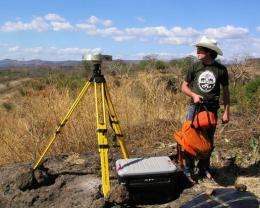Shaky Ground

University of Arkansas researchers have used measurements of tiny movements in the Earth's crust to gain a better understanding of earthquake dynamics in Nicaragua, where a large quake devastated the city of Managua in 1972. Their findings confirm a prediction of movement in the Earth's surface, but show little perpendicular strain associated with the movement, indicating a lack of coupling between the converging plates despite earthquake activity, a surprising finding.
University of Arkansas graduate student Henry L. Turner III, professors Pamela Jansma and Glen Mattioli of the University of Arkansas, Peter LaFemina of Penn State University, Armando Saballos of the Instituto Nicaragüense de Estudios Territoriales and Timothy Dixon of the University of Miami, Florida, reported their findings in the journal Geophysical Research Letters.
Nicaragua has a history of seismic activity, but little is known about the plate movements in the region and how they might be linked to earthquakes. Researchers know that the Earth's surface is broken into 12 major plates, with some minor plates. However, movement at the plate boundaries, where earthquake activity often occurs, varies, and in some places, like Nicaragua, the link between movement and earthquakes is poorly understood.
"We want to look at what the boundary is like," Turner said.
Using global positioning satellite technology, researchers have gathered data since 2000 that measure tiny movements of the Earth's surface at sites in Nicaragua. Researchers returned to the sites annually to collect data. Using the information gathered, Turner and his colleagues calculated the rate of movement along the Pacific coast of Nicaragua during that time frame.
They found that the region is moving to the northwest at a rate of about 15.1 millimeters per year relative to the Caribbean plate, a relatively fast clip in the world of plate movement. This movement corresponded well with a prediction made in 2001.
However, the researchers were surprised by a lack of perpendicular motion that would indicate the type of strain typical of earthquake-prone regions in subduction zones.
"There's definitely a large seismic hazard there," Turner said. "That makes you think that there's some coupling occurring on the plate interface." Coupling, or locking, happens when plate boundaries stick, then slip, creating the motion that causes earthquakes.
"It's possible that some of what we're seeing could be post-seismic relaxation," Turner said. Another possibility is that frequent, small events are releasing the energy that normally would build up, or the locked portion of the plate interface is too shallow and too far offshore for the arc-normal component of strain to be detected. Turner and his colleagues plan to develop more complex models to help determine the relationship between movement and earthquakes in the region.
"It's probably a combination of the three," Turner said.
Turner, Jansma and Mattioli are in the geosciences department of the J. William Fulbright College of Arts and Sciences. Turner is also a distinguished doctoral fellow in the Arkansas Center for Space and Planetary Sciences.
Source: University of Arkansas




















